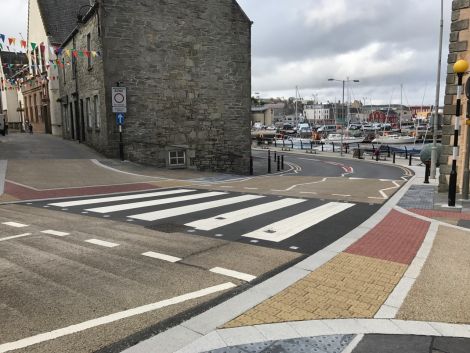News / SIC unlikely to dump the town centre bumps
SHETLAND Islands Council has poured cold water on suggestions that Lerwick’s new speed cushions could be removed in the future as part of a UK-wide drive to cut emissions.
The department for transport and DEFRA published a report last week on “tackling roadside nitrogen dioxide concentrations”, and one proposed measure to create cleaner air was to encourage councils to change road layouts and even get rid of road humps.
But roads manager Dave Coupe said that Shetland does not feature in a list of local authorities forecast to exceed emission standards and as a result is unlikely to need to undergo any drastic measures.
Critics of Lerwick’s recently-introduced £234,000 traffic calming works in the town centre appeared to welcome the government report last week in the hope that it could ultimately lead to speed bumps being removed.
The document said their stop-start nature causes vehicles to produce more emissions.
Coupe, however, said the report highlighted “road humps rather than speed cushions, which are used in the majority of Shetland’s traffic calming schemes”.
“This type of traffic calming may have been specifically named because research by the Transport Research Laboratory shows that the introduction of speed cushions results in a lesser increase in emissions than the introduction of road humps,” he continued.
“Road humps are the type of traffic calming used in South Commercial Street and has not been used in the 20mph scheme from Church Road to North Ness.”
He added that any removal of road humps would “have to be considered very carefully and weighed against the resulting increase in vehicles speeds and the likely increase in traffic accidents as a result.”
Work was recently completed on the traffic calming project in the centre of town as the council sought to reduce the number of accidents in the area and make the centre more pedestrian friendly.
Become a member of Shetland News
Nearly £170,000 of the cost was funded by national body Sustrans, with the SIC contributing £41,000 and the Scottish Government coughing up £25,000.
It reduced the speed limit from 30mph to 20mph from near the top of Church Road to North Ness, while raised zebra crossings were also put in place.
But some locals have criticised the cost and merits of the scheme, while some have commented that the speed cushions can be harsh to drive over.
Some local retailers have also expressed concern that the new measures may put off drivers from coming into town, reducing shops’ footfall as a result.
Transport and environment committee chairman Ryan Thomson, who also owns Tagon Stores in Voe, said he could understand some of the concerns over the traffic measures.
But he feels some shop owners are satisfied that the speed cushions being in place shouldn’t have a lasting impact on trade.
“I’ve spoken with some of the business owners on the street and the ones that I’ve had conversations with have noticed a difference with the road works, but don’t expect the speed bumps to have any longer term impact on trade,” Thomson said.
“Their concerns are understandable and as a business owner myself I am sympathetic to their concerns. We need to wait and see what sort of impact it will have, and liaise with business owners in the meantime.”
Become a member of Shetland News
Shetland News is asking its readers to consider paying for membership to get additional perks:
- Removal of third-party ads;
- Bookmark posts to read later;
- Exclusive curated weekly newsletter;
- Hide membership messages;
- Comments open for discussion.
If you appreciate what we do and feel strongly about impartial local journalism, then please become a member of Shetland News by either making a single payment, or setting up a monthly, quarterly or yearly subscription.





























































